This is an Exakta Twin TL, a 35mm single lens reflex camera built in Japan by Cosina for Ihagee Kamerawerk AG, also known as Ihagee West, starting in 1970. The Exakta Twin TL was a last ditch effort by the West German version of Ihagee to launch a new series of Ihagee SLRs with a new bayonet lens mount and more traditional ergonomics after the failure of the ambitious, but flawed Exakta Real of 1966. Sharing the same bayonet lens mount as the Exakta Real, the Exakta Twin TL has a TTL exposure meter, a vertically traveling focal plane shutter, and with it’s larger diameter lens mount, should have been able to support a wider variety of lenses than the original Exakta bayonet mount did. The Exakta Twin TL barely made a splash upon it’s release and even with a version of this camera with an M42 screw mount, sold poorly and failed to restore the prominence of the Exakta brand.
Film Type: 135 (35mm)
Lens: 50mm f/1.8 Exaktar Auto coated 6-elements in 4-groups
Lens Mount: Exakta Real Bayonet
Focus: 1.75 feet to Infinity
Viewfinder: Fixed SLR Pentaprism
Shutter: Copal Square Vertically Traveling Metal Blade
Speeds: B, 1 – 1/1000 seconds
Exposure Meter: (2x) CdS Meter with viewfinder match needle
Battery: 1.35v PX675 Mercury
Flash Mount: Hot Shoe and MX Flash Sync Ports, 1/125 X-sync
Weight: 987 grams (w/ lens), 765 grams (body only)
Manual: https://www.cameramanuals.org/exakta/exakta_twin_tl.pdf
How these ratings work |
The Exakta Twin TL was the last Exakta camera produced in either East or West Germany, and despite being made in Japan and sharing little in common with the original Dresden Exaktas, is still quite a nicely built camera. Available in both the Exakta Real’s bayonet mount and the M42 screw mount, the Exakta Twin TL has a Copal Square shutter with a wide range of shutter speeds, dual CdS meters with a match needle visible in the viewfinder, and came with an available assortment of high quality Japanese lenses. These are not easy cameras to find, but when found in good working order, are as good as anything coming out of Japan at that point. | ||||||
| Images | Handling | Features | Viewfinder | Feel & Beauty | History | Age | |
| 2 | 2 | 1 | 1 | 2 | 1 | 20% | |
| Bonus | none | ||||||
| Final Score | 10.8 | ||||||
History
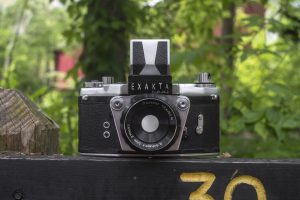
The story of the Ihagee Exakta Twin TL starts with the Ihagee Exakta Real from 1966, an all new camera that was built by the West German version of Ihagee in an attempt to relaunch the Exakta brand and restore it’s original prominence. I recommend reading the history section of that article first, to better understand how Ihagee West formed, who was responsible for it, and how the Exakta Real came to be and then come back here.
In their attempt to make the Exakta Real as good as it could be, Ihagee West faced multiple uphill battles. For starters the technological challenge of building an all new 35mm single lens reflex camera from the ground up was a tough task. In addition, the ownership of Ihagee had to spend considerable time and money in court battles for the right to use both the Ihagee and Exakta names as both were already trademarks of the East German arm of Ihagee. Finally, the entire German industry was faced with the rise of the Japanese camera industry who by the 1960s had well entrenched themselves as capable makers of cameras and lenses. It was no longer enough for the words “Made in Germany” to mean the highest quality available.
When the Exakta Real finally hit the market in 1966, it’s response was underwhelming. With a feature set that was already behind currently available models by other companies and a price higher than that of most cameras, it sold poorly. Ihagee West needed to find a way to offset both the camera’s development costs along with their legal expenses and in 1970 made the decision to outsource development of an all new camera to Japanese camera maker, Cosina.
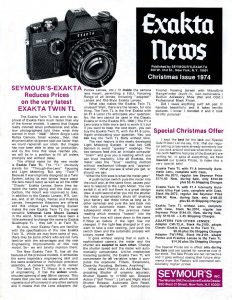
The Exakta Twin TL was based off the Cosina Hi-Lite, but was not a simple rebadge as it had several changes made specifically for Ihagee such as retaining the Exakta Real’s bayonet lens mount and also including a second shutter release on the photographer’s left side.
Compared to the Exakta Real, the Twin TL was a considerably more advanced camera, featuring an TTL CdS exposure meter with a viewfinder match needle, Copal Square vertically travelling focal plane shutter, 1/125 flash sync speed, and perhaps most significantly, a much lower price.
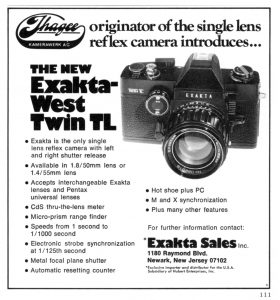 Shortly after it was first released, Seymour’s of New York sold the camera with a f/1.4 Exaktar lens for $219.50 and body only for $119.50. These prices were a far cry from those of the Exakta Real, which although I was never able to find a US price for one, in Germany, sold for a 60% increase over an already expensive Dresden Exakta.
Shortly after it was first released, Seymour’s of New York sold the camera with a f/1.4 Exaktar lens for $219.50 and body only for $119.50. These prices were a far cry from those of the Exakta Real, which although I was never able to find a US price for one, in Germany, sold for a 60% increase over an already expensive Dresden Exakta.
Despite the lower cost and improved feature set, the Exakta Twin TL still sold slowly. A camera with a German name, which by the 1970s was associated with an antiquated style, by a Japanese company using lenses that weren’t compatible with other lenses (an adapter to use regular Exakta lenses was available), and poor distribution likely combined to make the camera unappealing to most consumers.
In his April 1971 SLR column, Herbert Keppler wrote about currently available Exakta models such as the Dresden produced Exakta VX500 and Exakta RTL 1000, the German made Exakta Real, and the Japanese Exakta Twin TL, offering his take on ways in which the brand has been modernized.
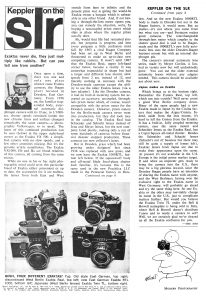
Keppler’s comments on the Twin TL suggest that at the time of this article, the camera wasn’t yet distributed in the US yet, and that there was no guarantee it would even come. Strangely, he references a Bell & Howell export of the camera in Italy, which I have never seen before.
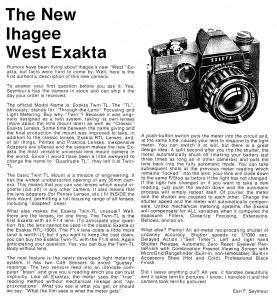
With the benefit of hind sight, the Exakta Twin TL was not a bad camera. It had a feature set on par with most consumer grade SLRs of the era. With the reputation and quality of Japanese camera and lens makers of the day, the camera should have been a success, but as I’ve covered above, a huge number of obstacles were in the way of it’s success.
Perhaps in an effort to salvage whatever they could with their partnership with Cosina, at some point a revised version of the Exakta Twin TL with an M42 screw mount in place of the Real bayonet mount was released which you can read about in the next section. Although I have never found any official release date for the Exakta Twin TL 42, I have to believe it came later, possibly in 1973 or 1974.
The 1970s saw the death of a number of camera brands including both the Dresden and West German Exaktas. It is not exactly clear when the Exakta Twin TL ended production, but the last of the original Exaktas, the VX500 ended production in 1972. Scaled down Exa cameras continued to be produced with the Exakta mount until 1977 at which time the Exa 1b was released which used the M42 screw mount, officially ending whatever remained of the DNA from the original 1930s Exakta.
Today, there are those who collect Exaktas and those who don’t For the latter half of people, there is little about the Exakta Twin TL that would appeal as either a collectible or a camera that you’d want to shoot. For the Exakta collector however, having one of these obscure models is interesting both from a rarity standpoint and that they represented the end of the line for the Exakta brand.
Ihagee Exakta Twin TL 42
Perhaps realizing that with the failure of the Exakta Real, launching yet another camera with the Real’s bayonet lens mount might be a risk, a version of the Exakta Twin TL with a 42mm screw mount was also available. I am uncertain if this was done by request of Ihagee West, or whether it was something Cosina, who at the time made other M42 cameras, insisted. I am also not certain if the 42mm version was launched at the same time as the bayonet version, or whether this model came later.
What I can tell you is that they do exist, and in my very unscientific opinion, based on the number that show up for sale on eBay, the M42 version must have been produced in lower numbers than the already low numbers of the bayonet version.
Besides the lens mount, the bayonet and M42 versions of the camera are identical as are the Exakta Auto 50mm f/1.8 lenses I have on each model. With a flange focal distance (the distance between the surface of the lens mount and the film plane) of 45.46mm, the M42 mount is close enough to that of the original Exakta mount, that any differences in distance could likely be easily corrected with shims inside of the lens.
Otherwise, the shutter, viewfinder, body, and other features are exactly the same, in fact, with the lens attached, other than the presence of the number ’42’ above the model name on the front face of the camera, there would be no other way to tell the two apart.
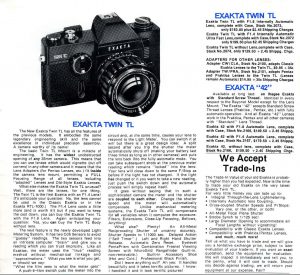
When it was available, the Ihagee Exakta Twin TL 42 sold for a small discount over the bayonet version. In the ad to the left from the July 1975 issue of Seymour’s Exakta News, a Twin TL 42 body sold for $109.50 plus tax compared to $129.50 for the bayonet version. Even with the f/1.4 lens, the prices of $179.50 and $199.50 still show the same $20 discount. When adjusted for inflation, the cost for a brand new Ihagee Exakta Twin TL 42 body and one with an f/1.4 lens compares to about $560 and $925 today.
After shooting the images for this review of the bayonet Exakta Twin TL, I came across this very worn, and non-working 42mm version and picked it up. As I always do with dead cameras, I thought perhaps that with a liberal dousing of naphtha oil and perhaps some ‘percussive maintenance’ I might be able to get the camera working, but this camera was too far gone. Amazingly, the camera came to me with a dented and scratched UV filter coated in gunk, but removing it revealed a pristine front element. Perhaps one day I’ll mount this lens to another M42 camera and give it a go, but for the body, this Exakta Twin TL 42 has already made it’s last exposure, probably decades ago.
Since the two cameras are identical other than lens mount, I didn’t think it made sense to ever give this 42mm version it’s own review, so I am including a small gallery in it’s own section for the bayonet Exakta Twin TL review.
My Thoughts
There have been many cameras made over the years, and despite surpassing 300 camera reviews earlier this year, I know that I won’t be able to review them all. When it comes time to choose which cameras get a full review, my criteria requires there to be something special about them. Special does not always have to mean good, as any camera, no matter how cheap or basic can still be special.
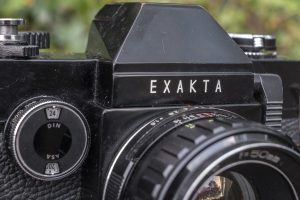
If given the chance to review a Cosina Hi-Lite which the Exakta Twin TL is based off, I likely would pass as it’s a pretty run of the mill, mechanical Japanese camera, but the Exakta represents a curiosity for me. Not only was it the last hurrah of the offshoot of a once great camera maker, it is one of only two cameras ever made with the Exakta Real bayonet mount…plus, it looks great in black!
This was a camera sold in very low numbers, so finding one in good enough condition for the right price was a challenge, but luckily, I have plenty of time, so with patience on my side, I kept a look out until a nice one and supposedly perfectly working came along.
When it arrived, true to it’s description, the camera worked great, even the meter responded to light and appeared to be accurate. Unlike the Exakta RTL 1000 of the same era which also has a vertically traveling focal plane shutter, the Copal Square one used by Cosina is much more reliable. In my experience and in talking to other collectors, many of the Dresden area vertically traveling shutters do not hold up nearly as well as their Japanese counterparts. If deciding between the Twin TL and the RTL 1000, based purely in the chances of it working, the Twin TL is the much better option.
With the Exaktar 50mm f/1.8 lens and a battery installed, the camera comes in at a not insignificant 987 grams which is heavier than a 1960s Exakta VX1000 with Zeiss Pancolar 50mm f/2 lens at 923 grams. Even with the lenses removed, the body of the Twin TL is still 28 grams heavier.
Build quality is quite good, definitely up to typical German and Japanese standards of the day with no creaking or excessive use of plastic or other cost savings materials. The top and bottom plates are solid brass, as evidenced by the brassing that is visible around the edges on this example.
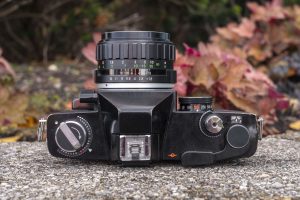
From left to right, the top plate has the fold out rewind knob atop a film type reminder disc. Atop the pentaprism is a standard flash hot shoe, which on this example, still has the original plastic filler piece, suggesting it was likely never used in it’s life time. To the right of the prism is the large cable threaded shutter release button with a locking dial below it, the rapid advance lever, and automatic resetting exposure counter. A large empty void exists in the location where you would normally expect to find the shutter speed dial, which on the Twin TL, and the Cosina camera it is based off, is located on a large dial on the front face of the camera.
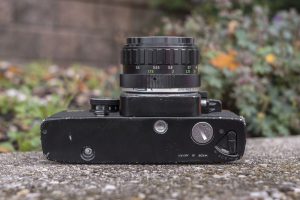
Flip the camera over, and the bottom plate has the rewind release button, centrally located metal 1/4″ tripod socket, battery compartment for the 675 mercury battery, and the film compartment door release lever. With a nod to the Exakta’s German roots, both the film door lever and battery door are labeled in German with the word “auf” for open, which is kind of odd as right next to it are the words “Made in Japan”.

The camera’s left side is where you’ll find both M and X flash sync ports. Also visible on the left side of the mirror box is the bayonet lens release button, lever for enabling the CdS meter and stopping down the lens, and the camera’s left handed shutter release, all three of which are features not found on the original Cosina camera.
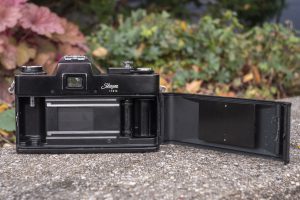
With the film back open, we see a rather ordinary 35mm film compartment. Film travels from left to right over two polished film rails and onto a double slotted and fixed take up spool. The take up spool rotates clockwise which means that as the film is advanced, it rolls opposite of how it was in the cassette, which is said to improve film flatness. The inside of the film door has a large and divoted film pressure plate. Like most Japanese SLRs of it’s era, the Exakta Twin TL has foam light seals which will need to be replaced to prevent light leaks.
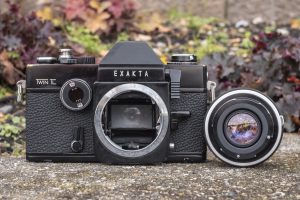
Up front, the Exakta Twin TL shares the same three claw bayonet as the Exakta Real and supports all of the lenses made for it, along with a line up of Cosina produced lenses that were made for this camera. The Real bayonet has a large 46mm throat which is similar to that of the Nikon F-mount. Had this mount been more successful, it’s size would have allowed for very wide and heavy lenses to be developed for it.
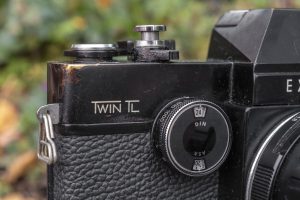
Also up front, above the mechanical self timer lever, is a combined dial for both shutter speeds and film speeds. The outer edge of the dial has shutter speeds from 1 – 1/1000 plus Bulb engraved on it, and through two small windows on the front face are ASA and DIN speeds from 25/15 to 1600/33.
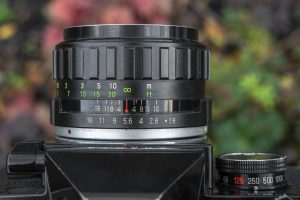
When Ihagee West released the Exakta Real, they sourced new lenses primarily from A.Schact and Schneider-Kreuznach, and although all of those lenses worked on the Twin TL, the new camera had a new list of Cosina produced lenses available for it.
Despite being made in Japan, the new lenses were of equal quality, featuring all metal bodies with metal aperture and focus rings. The focus ring in particular is wide and has thick ribs on it, making it very easy to grip. On the 50mm f/1.8 Exaktar Auto, f/stops from f/1.8 to f/16 are selected with positive clicks at each stop. The lens mounts securely to the body without any play or looseness.
The viewfinder is of average size and brightness for a 1970s SLR. The focusing screen has a small microprism circle in the center, surrounded entirely by a ground glass screen. Considering the era in which this camera was built, it is disappointing to not see a split image focusing aide, or even a larger microprism circle, but at least brightness is even from corner to corner, and even indoors, is barely noticeable. I do not see any evidence of a Fresnel pattern, so if it’s there, it is very finely grained. Off to the right is the meter’s match needle which shows a plus and minus size for over and under exposure above a notch which indicates correct exposure. No other information is visible through the viewfinder.
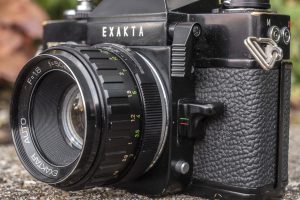
Under normal operation, the meter is off and the lens diaphragm is wide open. Exakta Real mount lenses support automatic diaphragms without any external linkage like the original Exakta mount did. With the diaphragm open, you can choose any f/stop on the lens you want and it will stay open, however the meter is disabled.
In order to use the meter, you must press down on the black lever on the left side of the lens so that a thin green line is next to a small white dot. With the lever in this position, the CdS meter becomes energized and the lens stops down to whatever f/stop you’ve selected on the lens. The meter does not work in conjunction with the automatic diaphragm feature, which means when composing your image through the viewfinder with the meter on, the viewfinder will darken depending on which f/stop you’ve selected.
Each time the shutter release is pressed, the meter switch will return to the off position where a red line is next to the white dot, the meter will stop responding to light, and the automatic diaphragm feature starts working again. This workflow slows you down compared to more modern cameras in which the meter can work with the lens wide open, but this was fairly common in the era of metered SLRs around 1970.
The left handed shutter release on the Twin TL is physically connected to the top plate shutter release on the right. As you press the left one, the right one will move. There is no practical reason for the Twin TL to have this second shutter release when using the Real bayonet lenses or M42 lenses on the M42 version of this camera, but there was an adapter ring available that allowed use of original Exakta lenses on this camera, which would have allowed those lenses to work with the shutter release on this camera. If you are left handed and want to use the lever, you can as it’s actually quite comfortable to use, but otherwise, the top plate shutter release works great.
My Results
When the Exakta Twin TL showed up, the camera was in excellent condition, both cosmetically and operationally. I was so certain that the camera was in good working order that for my first roll through it, I chose my all time favorite film, Kodak Panatomic-X. This film has not been produced in decades, but as I’ve stated on this site many times before, seems to defy time as in all the times I’ve used it, it has remained viable at box speed, sometimes even benefitting from half a stop of under exposure. Metering for ASA 50, I shot the gallery of images below while walking around my neighborhood in the spring of 2021. All were hand held, except the ones of the Pioneer receiver, turntable, and network switches, which I had the camera mounted to a tripod.
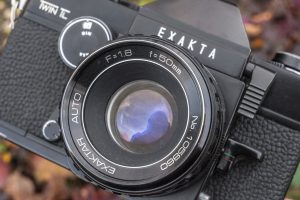
Although not labeled as such, the Cosina produced Exaktar produced results consistent with what you’d expect from an early 1970s Japanese lens maker would, which is to say, outstanding.
Kodak Pan-X is a low contrast film which shows a huge amount of shadow detail when shot through lenses with a lot of resolution. The results from the Exaktar lens compare favorably to similar results I’ve received using this film while shooting through other A-list Nikkor, Rokkor, and Zeiss lenses. Sharpness is consistent corner to corner with no edge softness, vignetting, or other optical anomalies associated with lesser lenses.
I did not shoot any color film with this camera and lens combination but expect more of the same excellent images with sharpness corner to corner, excellent color rendition and no obvious chromatic aberrations.
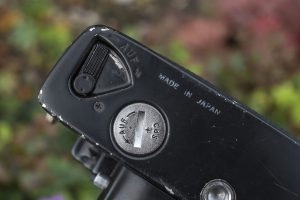
Shooting the Exakta Twin TL was a mostly positive experience with it’s biggest cons coming with the stop down metering system. For someone looking to buy a metered camera in the early to mid 70s when this was a current model, there were already cameras out there with open aperture metering, and for those working on a budget, were only a year or two away from cheaper models that would have this feature. Considering the prices listed in the Seymour’s advertisements above, I can’t help but imagine owners of this camera having some buyer’s remorse upon seeing the large amount of new models that didn’t need to darken their viewfinder when metering.
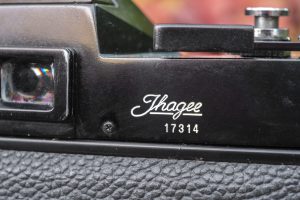
With that con out of the way however, the Exakta Twin TL was a good budget camera, and one that could very easily make excellent images. The camera was a failure in the sense that it sold poorly, and did little to improve the image of the Exakta brand, but as a fully mechanical 1970s SLR, does it’s job quite well.
In a way, cameras like these that didn’t connect with too many people when they were first released, are often more appealing today as they are a fun way to shoot some film using a well made and interesting camera. I found that as long as I shot in consistent lighting, I only needed to take one reading with the meter, then leave it off for the remainder of shots that were done in similar lighting.
Overall, the Exakta Twin TL is a nice camera that I am happy to have in my collection. It doesn’t do anything better than dozens of other, similar cameras from the era, but it has a name you don’t often associate with 1970s cameras, and a design that’s just different enough to make it stand out from those other models. If you can find one of these in nice working condition, they’re definitely worth picking up, but like they sold for in the mid 1970s, just make sure you don’t pay too much for one!
Related Posts You Might Enjoy
External Links
http://camera-wiki.org/wiki/Exakta_Twin_TL
https://www.pacificrimcamera.com/pp/exaktatwintl.htm
lll
http://exaktaphile.net/captjack/Exakta%20Twin%20TL%20&%20Later%20Pseudo%20Exaktas.htm

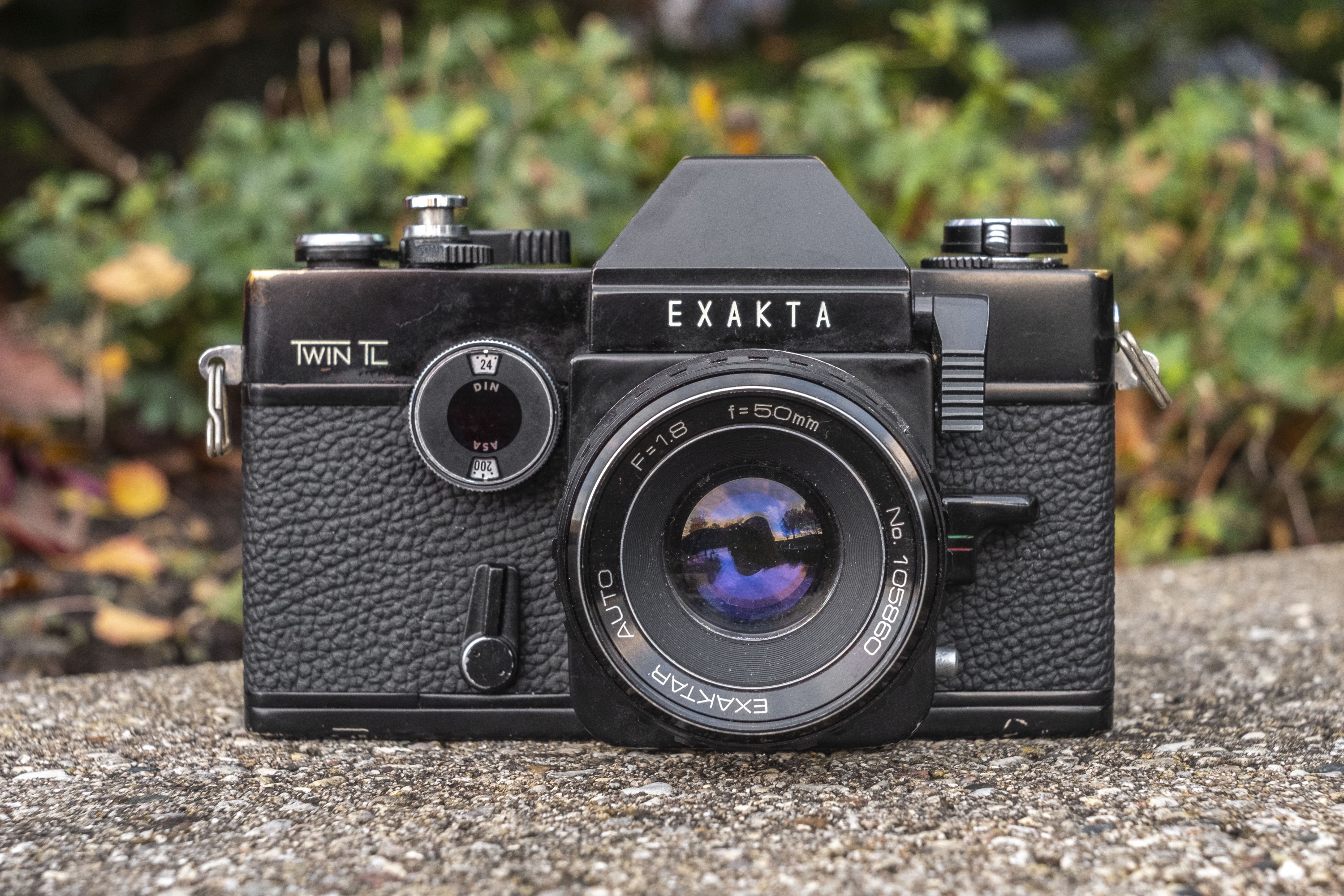
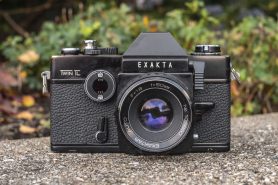










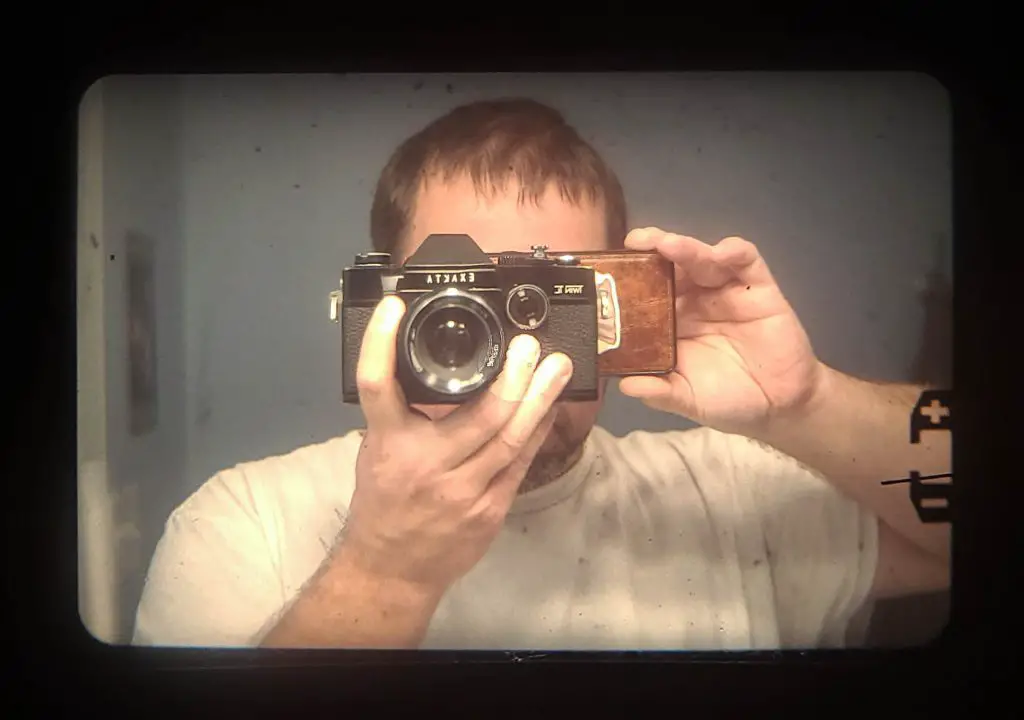
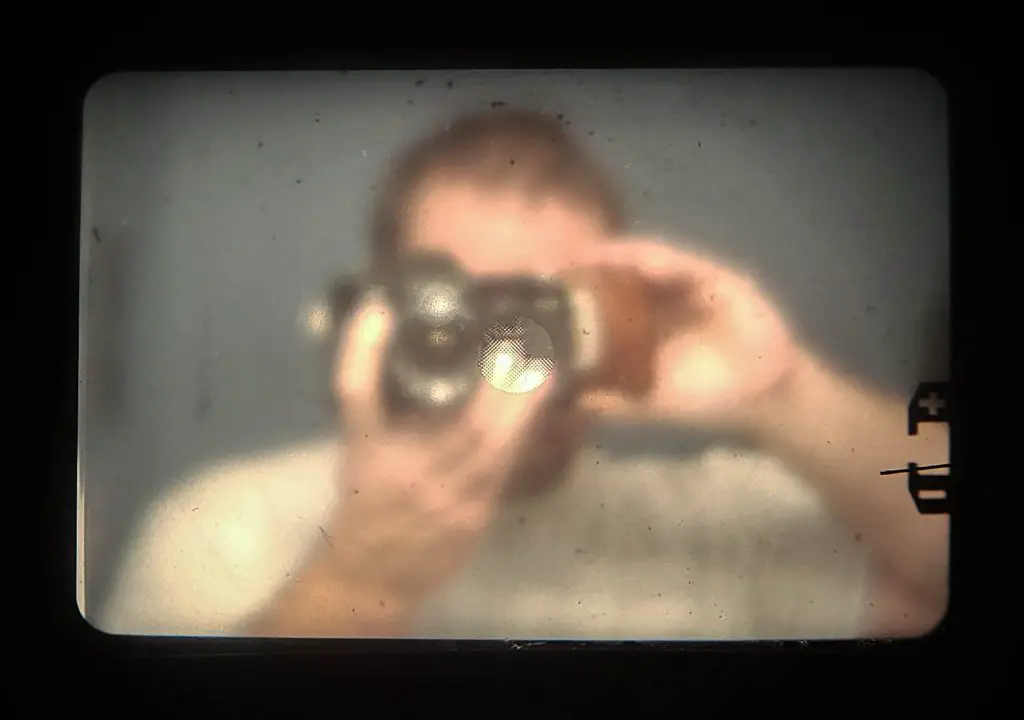















A review of an interesting and obscure that suggests a new series for you to launch: Orphan Lens Mounts!
Yeah, that would make for an interesting article. There are so many orphaned lens mounts, I could do an entire article on just SLRs and another on rangefinder. Earlier this year, I did a review on the Argus SLR which has a distinct mount not used on any other camera. There’s also the KMZ Start too…so many.
I have a decent Exakta collection and bought an Exakta Twin TL as the last Exakta and to use my many great Exakta VX lenses. The adapter is quite rare but works nicely. I agree the Twin TL’s stop down metering is a pain but I feel it is a whole lot better than the other attempts to have a TTL Exakta metering, such as the Examat and the Travemat meter prisms for the original VX style Exaktas and the incomprehensible Exakta RTL meter prism. Thanks for the excellent review!
Thanks, Great information I have an excellent model M 42 that I’m getting ready to put on eBay. Not that I don’t like it I just have too many cameras and not enough time to shoot them on – trying to narrow it down so I can shoot more and maintain less systems . It look like new And functions perfectly. Thanks for the help, Joe
Thanks for the feedback Joe! To be honest, I would sell mine too as I don’t need a bayonet and M42 version, but my M42 version is completely siezed and I just like the patina on it! 🙂
Thanks for the thorough review. I would add that the Twin TL also had an optional adapter for M42 lenses, making it perhaps the most versatile SLR of its era in terms of lens compatibility. Both the classic Exakta and M42 adapters enable full auto diaphragm operation, something M42 adapters for other cameras don’t support. The Tomioka designed f1.4 Exaktar made for the Twin TL actually uses an M42 adapter!